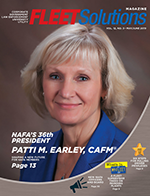NAFA's FLEETSolutions: Interview With FMCSA Administrator Raymond P. Martinez Reveals ELD Flexibility is Key
![]() Print this Article | Send to Colleague
Print this Article | Send to Colleague
 The May/June issue of NAFA's FLEETSolutions features an extensive interview with Federal Motor Carrier Safety Administration (FMCSA) Administrator Raymond P. Martinez. The magazine is a benefit of NAFA membership and also includes interviews with NAFA President Patti Earley, CAFM®; NAFA Past President Bryan Flansburg, CAFM; a look at the current fuels market; and vehicle wraps as a branding option.
The May/June issue of NAFA's FLEETSolutions features an extensive interview with Federal Motor Carrier Safety Administration (FMCSA) Administrator Raymond P. Martinez. The magazine is a benefit of NAFA membership and also includes interviews with NAFA President Patti Earley, CAFM®; NAFA Past President Bryan Flansburg, CAFM; a look at the current fuels market; and vehicle wraps as a branding option.
Martinez previously served eight years as the New Jersey Motor Vehicle Commission’s chairman and chief administrator (2010-2018), where he oversaw the agency’s 2,500 employees and a $330 million annual operating budget with more than $1 billion in annual revenue.
Prior to this, Martinez was commissioner of the New York State Department of Motor Vehicles (2000-2005) and served at the U.S. Department of State. He is the sixth administrator of FMCSA and was sworn into office by U.S. Department of Transportation Secretary Elaine L. Chao on February 28, 2018.
Martinez prioritized outreach as FMCSA’s main motivator, saying, "Our means is not to hit [noncompliant carriers] so hard with the penalties stick that they go out of business." The agency regulates the trucking industry in the United States; its primary mission being the reduction of crashes, injuries, and fatalities involving large trucks and buses.
"Our goal, as it pertains to safety, is always getting to zero. FMCSA is a part of the National Safety Council’s Road to Zero Coalition."
Likewise, NAFA Fleet Management Association is a partner in FMCSA’s "Our Roads, Our Safety" effort (www.fmcsa.dot.gov/ourroads). The initiative seeks to enlighten passenger vehicle and small- and medium-duty truck drivers to the unique challenges and potential dangers in sharing roads with buses and large trucks. "We reach out to entities that are not in these two segments to share information with their stakeholders. We thank NAFA so much for joining with us and other industry groups, safety advocates, and like-minded organizations in this effort."
Changing minds and attitudes is not an easy task. So many drivers haven’t a clear idea of what it takes to drive a large vehicle and, more importantly, what it takes to stop one. "You have vehicles that carry both mass and speed, and when a passenger vehicle cuts in front of a commercial vehicle, or it stops inappropriately, it’s no longer an argument about the truck driver wanting to stop. It’s that they can’t." Trucks that can weigh more than 40 tons traveling 65 mph will take up to two football fields (approximately 720 feet) to stop. Factor in a commercial vehicle’s need to make wide turns and deal with large blind spots, and the need for greater understanding is clear.
Modern Commerce and Expectations - The number of commercial vehicles on roadways and their vehicle-miles-traveled are in direct relation to the health of the economy. "As the economy gets stronger and grows, the number of delivery vehicles will rise," Martinez said. "Much of this is due to the rise of e-commerce, but also when individuals have more money at their disposal, they will spend it. This leads to an increase in buses on the roadways as well, particularly in coastal and urban areas."
With more and larger vehicles occupying the roads, said Martinez, so too would there be a rise in crashes, injuries, and fatalities. "The ‘right now’ economy has created a mindset where consumers who buy something online in the morning expect it delivered that same afternoon. Until you have drones delivering parcels, trucks will be the dominant component in the process.
"We’re seeing to it that the industry holds itself to the highest standards before FMCSA needs to intervene with violations," he said. "We expect that they will conduct business beyond mere compliance."
Hours of Service and ELDs - FMCSA is taking the lead on several key issues, each presenting relevance to the next. For example, in late February, the agency announced it is planning to propose a rule to overhaul hours of service regulations. It has been receiving data from motor carriers through the Electronic Logging Device (ELD) mandate that highlights areas in the current existing hours-of-service regulations that may need to adjust or improve.
FMCSA received more than 5,000 specific comments for the Advance Notice of Proposed Rule-Making issued August 2018. Through this, the agency indicates that greater flexibility for splitting on-and off-duty time into segments is likely to be included in the proposal.
"We believe ELDs will, over time, prove to be a tremendous benefit to safety in that it will keep [time-logging] on-track and honest, and hopefully make the process a lot easier," Martinez said. "The data we now have suggests we need more flexibility, not necessarily because carriers want to drive 24 hours straight per day. If a carrier is traveling through a wide open region with greater distances to cover or in areas like the East or West Coast where travel time is diminished through congestion, you understand that need for flexibility."
The full conversation with Martinez can be found in the latest issue of FLEETSolutions, or online at https://www.nafa.org/Publications/FLEETSolutions.aspx

